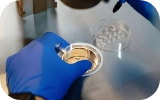Andropause

Andropause or male menopause is the term used to describe reducing levels of testosterone due to hormonal changes in men as a result of ageing. This is, however, a completely different situation from that of menopause in women. In women, menopause brings about a complete end to ovulation over a relatively shorter period of time. In men, on the other hand, the decreased testosterone levels and hormone production occurs more gradually. Medical professionals may use the term ‘Late Onset Hypogonadism’ for extremely low levels of male hormones.
Once you cross the age of 30, there will be a slow decline in testosterone by approximately 1% each passing year. This means that the testes do not completely stop producing testosterone. However, as a result of diabetes and certain other factors mentioned below, there could be minutely noticeable changes in the function of the testes between 45 to 50 years of age.
Symptoms Of Male Menopause
Age is the most common factor that contributes to andropause. Once a man crosses 70 years of age, he may experience up to a 50% decline in testosterone levels. Other factors that can cause lower testosterone levels are: obesity, type 2 diabetes, hormonal disorders, liver or kidney disease, and infections. Common symptoms of andropause include:
- Increase in body fat
- Erectile dysfunction
- Decreased libido (low sex drive)
- Disturbance in sleep patterns
- Thinning of skin
- Dryness of skin
- Mood swings and Irritability
- Depression
- Lack of energy
- Hot flushes
- Muscle mass reduction
- Reduced ability in concentrating
- Excessive sweating or Hyperhidrosis
It is important to note that signs and symptoms of andropause can differ from person to person. Men who experience male menopause also have an increased risk of developing certain complications like osteoporosis and cardiovascular problems.
Diagnosis, Treatment And Prevention Of Andropause
Andropause is generally diagnosed by an urologist or a male fertility expert (Andrologist), by way of a physical examination and detection of accompanying symptoms. The medical expert may also order a few diagnostic tests to figure out whether the condition is due to any medical problem, followed by blood tests to measure testosterone levels of the patient.
Symptoms associated with male andropause are potentially treatable. However, to reverse the decline in testosterone levels, certain lifestyle changes will be recommended. This could be a combination of an exercise program and dietary changes. Medication or testosterone replacement therapy might be suggested in selected cases, but it is known to have some harmful side effects. The pros and cons of hormone injections can be discussed with your doctor.
Have you experienced symptoms that could be an indicator of low testosterone levels? Leave your thoughts and comments below.
 Infertility Counselling
Infertility Counselling Female Infertility Treatment
Female Infertility Treatment Andrology Treatment
Andrology Treatment Fertility Enhancing Surgeries - Female
Fertility Enhancing Surgeries - Female Fertility Enhancing Surgeries - Male
Fertility Enhancing Surgeries - Male Endoscopy Treatment
Endoscopy Treatment IUI Treatment
IUI Treatment IVF Treatment
IVF Treatment ICSI Treatment
ICSI Treatment Advanced IVF Solutions
Advanced IVF Solutions Embryology
Embryology Vitrification Egg, Embryo, Sperm Freezing
Vitrification Egg, Embryo, Sperm Freezing Preimplantation Genetic Testing (PGT)
Preimplantation Genetic Testing (PGT) Donation Program Embryo / Egg / Sperm
Donation Program Embryo / Egg / Sperm Self-cycleTM IVF
Self-cycleTM IVF

 Self-cycleTM IVF
Self-cycleTM IVF










